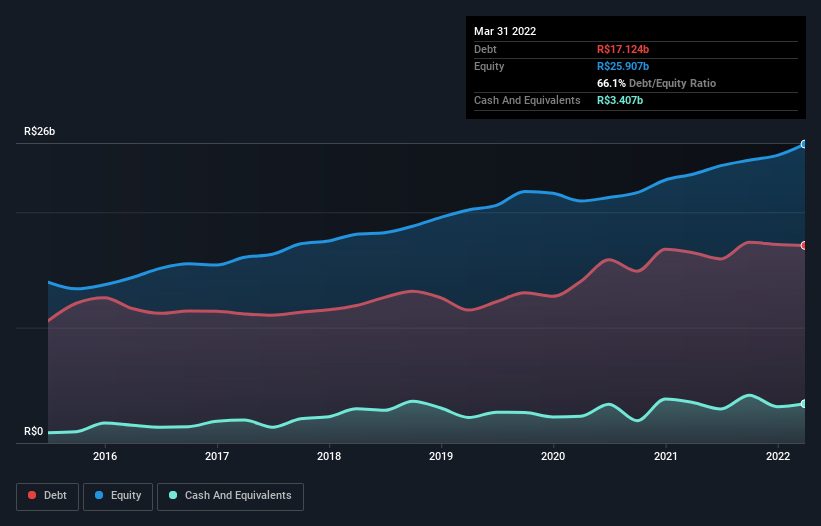- Brazil
- /
- Water Utilities
- /
- BOVESPA:SBSP3
Does Companhia de Saneamento Básico do Estado de São Paulo - SABESP (BVMF:SBSP3) Have A Healthy Balance Sheet?

Warren Buffett famously said, 'Volatility is far from synonymous with risk.' When we think about how risky a company is, we always like to look at its use of debt, since debt overload can lead to ruin. As with many other companies Companhia de Saneamento Básico do Estado de São Paulo - SABESP (BVMF:SBSP3) makes use of debt. But should shareholders be worried about its use of debt?
When Is Debt Dangerous?
Generally speaking, debt only becomes a real problem when a company can't easily pay it off, either by raising capital or with its own cash flow. Part and parcel of capitalism is the process of 'creative destruction' where failed businesses are mercilessly liquidated by their bankers. However, a more frequent (but still costly) occurrence is where a company must issue shares at bargain-basement prices, permanently diluting shareholders, just to shore up its balance sheet. Of course, debt can be an important tool in businesses, particularly capital heavy businesses. When we think about a company's use of debt, we first look at cash and debt together.
View our latest analysis for Companhia de Saneamento Básico do Estado de São Paulo - SABESP
How Much Debt Does Companhia de Saneamento Básico do Estado de São Paulo - SABESP Carry?
As you can see below, Companhia de Saneamento Básico do Estado de São Paulo - SABESP had R$17.1b of debt, at March 2022, which is about the same as the year before. You can click the chart for greater detail. However, because it has a cash reserve of R$3.41b, its net debt is less, at about R$13.7b.

A Look At Companhia de Saneamento Básico do Estado de São Paulo - SABESP's Liabilities
We can see from the most recent balance sheet that Companhia de Saneamento Básico do Estado de São Paulo - SABESP had liabilities of R$5.21b falling due within a year, and liabilities of R$23.0b due beyond that. Offsetting this, it had R$3.41b in cash and R$3.23b in receivables that were due within 12 months. So its liabilities outweigh the sum of its cash and (near-term) receivables by R$21.6b.
This deficit is considerable relative to its market capitalization of R$33.1b, so it does suggest shareholders should keep an eye on Companhia de Saneamento Básico do Estado de São Paulo - SABESP's use of debt. This suggests shareholders would be heavily diluted if the company needed to shore up its balance sheet in a hurry.
We measure a company's debt load relative to its earnings power by looking at its net debt divided by its earnings before interest, tax, depreciation, and amortization (EBITDA) and by calculating how easily its earnings before interest and tax (EBIT) cover its interest expense (interest cover). Thus we consider debt relative to earnings both with and without depreciation and amortization expenses.
Companhia de Saneamento Básico do Estado de São Paulo - SABESP's net debt of 2.2 times EBITDA suggests graceful use of debt. And the alluring interest cover (EBIT of 9.4 times interest expense) certainly does not do anything to dispel this impression. The bad news is that Companhia de Saneamento Básico do Estado de São Paulo - SABESP saw its EBIT decline by 10% over the last year. If that sort of decline is not arrested, then the managing its debt will be harder than selling broccoli flavoured ice-cream for a premium. The balance sheet is clearly the area to focus on when you are analysing debt. But ultimately the future profitability of the business will decide if Companhia de Saneamento Básico do Estado de São Paulo - SABESP can strengthen its balance sheet over time. So if you want to see what the professionals think, you might find this free report on analyst profit forecasts to be interesting.
Finally, a business needs free cash flow to pay off debt; accounting profits just don't cut it. So it's worth checking how much of that EBIT is backed by free cash flow. In the last three years, Companhia de Saneamento Básico do Estado de São Paulo - SABESP created free cash flow amounting to 16% of its EBIT, an uninspiring performance. For us, cash conversion that low sparks a little paranoia about is ability to extinguish debt.
Our View
Neither Companhia de Saneamento Básico do Estado de São Paulo - SABESP's ability to grow its EBIT nor its conversion of EBIT to free cash flow gave us confidence in its ability to take on more debt. But its interest cover tells a very different story, and suggests some resilience. It's also worth noting that Companhia de Saneamento Básico do Estado de São Paulo - SABESP is in the Water Utilities industry, which is often considered to be quite defensive. When we consider all the factors discussed, it seems to us that Companhia de Saneamento Básico do Estado de São Paulo - SABESP is taking some risks with its use of debt. So while that leverage does boost returns on equity, we wouldn't really want to see it increase from here. There's no doubt that we learn most about debt from the balance sheet. However, not all investment risk resides within the balance sheet - far from it. For example, we've discovered 3 warning signs for Companhia de Saneamento Básico do Estado de São Paulo - SABESP that you should be aware of before investing here.
At the end of the day, it's often better to focus on companies that are free from net debt. You can access our special list of such companies (all with a track record of profit growth). It's free.
New: AI Stock Screener & Alerts
Our new AI Stock Screener scans the market every day to uncover opportunities.
• Dividend Powerhouses (3%+ Yield)
• Undervalued Small Caps with Insider Buying
• High growth Tech and AI Companies
Or build your own from over 50 metrics.
Have feedback on this article? Concerned about the content? Get in touch with us directly. Alternatively, email editorial-team (at) simplywallst.com.
This article by Simply Wall St is general in nature. We provide commentary based on historical data and analyst forecasts only using an unbiased methodology and our articles are not intended to be financial advice. It does not constitute a recommendation to buy or sell any stock, and does not take account of your objectives, or your financial situation. We aim to bring you long-term focused analysis driven by fundamental data. Note that our analysis may not factor in the latest price-sensitive company announcements or qualitative material. Simply Wall St has no position in any stocks mentioned.
About BOVESPA:SBSP3
Companhia de Saneamento Básico do Estado de São Paulo - SABESP
Provides basic and environmental sanitation services in the São Paulo State, Brazil.
Outstanding track record and fair value.


